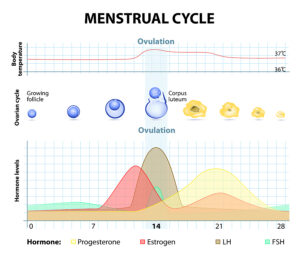A new study shows that girls are getting their first period earlier than in previous centuries. The first period has the name menarche. The study in JAMA Network Open also noted that it takes longer for girls to develop regular periods. The data is based on 71,341 US female individuals born between 1950 and 2005. It found that various factors influence when a girl develops her first period. The body mass index at the time of the menarche determines whether the period starts earlier (with a greater BMI) or later (normal BMI). Non-Hispanic, Black or Asian girls tended to have earlier menarches. Surprisingly, a lower socioeconomic status was also associated with an earlier menarche.
Earlier menstrual periods associated with poor health
Dr. Eve Feinberg is an associate professor of obstetrics and gynecology at Northwestern University’s Feinberg School of Medicine in Chicago. She said: “Menstruation is like a vital sign. You want to make sure that the body is regulated. And when cycles are not regular, it’s generally a sign that something else may be going on.”
Dr. Zifan Wang is a postdoctoral research fellow at Harvard University’s T.H. Chan School of Public Health. He said:” Scientists and health care providers already know that early periods and a longer time for cycles to regulate are associated with poor effects on health, including cardiovascular disease and cancer.”
“The longer people have irregular menstrual cycles, the longer they may be exposed to an imbalance between two important hormones: estrogen and progesterone”, Feinberg said.
There are multiple factors that may cause earlier periods in girls and more irregular periods initially.
Multiple causes of earlier menstrual periods
Between 1950 and 1969 the average age at menarche was 12.5 years. However, girls between 2000 and 2005 had their menarche at 11.9 years. This was verified with 71, 341 female individuals who were analyzed from the Apple Women’s Health Study. Some of the factors for earlier periods in girls is as follows.
- Body mass index (BMI) accounts for about 46% of earlier menarche. This was calculated in a sophisticated statistical analysis.
- As mentioned at the beginning of this review racial differences account for some of the variation of the menarche (earlier versus later).
- endocrine-disrupting chemicals in our environment and in the food chain can account for some cases of earlier menarche.
- Increased sugar intake can lead to insulin-mediated hormonal changes that can influence the onset of the menarche.
- psychosocial stress and adverse childhood experiences can also influence when the menarche occurs first.
Conclusion
According to Dr. Feinberg the first menstruation (menarche) in girls is like a vital sign. If it is earlier than at 12.5 years, there is a factor that causes this. These factors can be obesity, exposure to endocrine-disrupting chemicals, increased sugar intake with insulin-mediated hormonal changes or psychosocial stress. A second factor is the establishment of regular cycles in girls after the menarche. If it takes a longer time for cycles to regulate, this is associated with poor effects on health later in life. Health problems like cardiovascular disease and cancer have links to earlier menarches in girls. In addition, longer times to establish regular periods also show a relationship.







